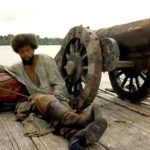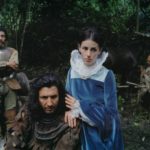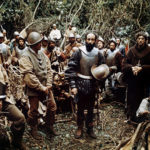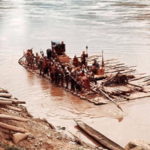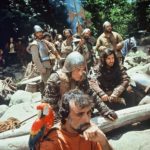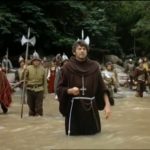Time to review another classic, and make no mistake Aguirre, The Wrath of God is an authentic masterpiece, as well as a fascinating use of the colon in some (incorrect) depictions of the film title.
It’s flawed masterpiece to be sure, but truly gob-smacking, as they say. It’s as much a drama for what took place off-screen as the action on screen, but the legendary love-hate relationship between director Herzog and star Kinski only fuelled the cult status of this movie, and indeed the four other movies they made together. It’s worth pursuing the documentary My Best Fiend to find out more of their incredible bond and antipathy (see part 1 and part 2.)
In reality it’s much more than just a drama about men on a makeshift boat. It’s a venture into the extremes of human consciousness, literally and metaphorically. Yes, there are power games afoot, but what separates this from other adventure movies set in the Amazon jungle is this: All the stunts, through appalling conditions, rapids and every danger portrayed was done for real. Herzog was never less than authentic, so his actors had no choice but to put their own lives at risk to deliver a convincing result. Commitment was absolute.
Perhaps the interesting question would be what makes ATWOG a masterpiece where thousands fail the test, since a minimalistic story of an ill-fated expedition down the rivers Orinoco and Amazon by ill-prepared Spanish Conquistadores and their Indian slaves to find the mythical city of gold, El Dorado in 1560, which as the opening captions point out was an invention by the Indians to lead the Spanish into dangerous territory and thereby kill them – either through disease, climate, injury or tribes equipped with poisoned arrows.
That it would an abject failure was entirely foreseeable, but the reason it fails is Don Lope de Aguirre, who, while nominally second in command, serves no useful purpose on the mission, leads a mutiny and ultimately leads the conquistadores to their deaths. Aguirre never gives up his pursuit of wealth and power, even when it is plainly obvious that the mission is doomed and the whole crew will die.
The real allegory here is that Aguirre, the man who declares himself the “Wrath of God,” represents the devil incarnate, whose only real motive is to destroy what is around him and to seek that which benefits him. Then again, this is a film which, in spite of its remarkable simplicity, you can read in other ways. It is almost a parable, though its moral might be might well split audiences and critics alike.
What you can say with certainty is that Kinski is mesmerising, not in the sense of doing a look-at-me-song-and-dance-act but through sheer charisma, a brooding yet towering presence on screen that captures your attention in every shot: the high cheek-bones, the sunken eyes, the almost translucent skin, the strange posture that makes him look deformed. You simply can’t afford to take your eyes off the man, for fear of what his paranoid brain might dream up next.
As an actor, Kinski was a latter-day Brando, he possessed the ability to inhabit the skin of his character so totally that you could never picture him in any other guise. Nothing about the emotional framework Kinski created in any of his characters is artificial, never does it seem like acting.
For the record, Kinski’s whole life was equally tumultuous, accompanied by psychiatric illness, multiple marriages, turbulent relationships with his three children and died of a heart attack shortly after his 65th birthday. Like Peter Sellers, Kinski was his art – and thankfully for us, his art was captured on film. whatever his flaws as a man, as an actor he was peerless and terrifying in his intensity. Maybe that is the sacrifice you need to make for your art.
Even allowing for the rough-and-ready quality of the film, there is so much to admire. It possesses a hauntingly elegiac quality that you can’t brush on with special effects, especially the final shot where the camera pans in circles around the flimsy raft, where a defiant Aguirre is standing around the corpses of the expedition members.
There is one low-tech effect though: the head flying from the shoulders of the decapitated soldier, but then finishing his sentence!
Long periods without dialogue are combined with shots to portray the beauty of nature and local wildlife. You couldn’t fail to admire the sheer majesty of the river, the rapids and the jungles beyond. The Indian tribes are either forced into slavery or prove hostile, yet they are as much a part of the landscape as the Spanish are foreigners. ATWOG is almost a natural history film as much as a drama based on reality.
Morals of the tale: fools rush in where angels fear to tread; all that glisters is not gold.



